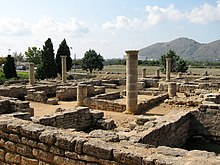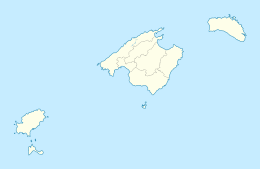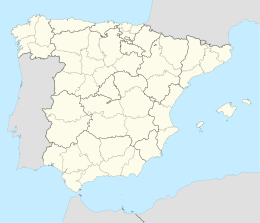
A | B | C | D | E | F | G | H | CH | I | J | K | L | M | N | O | P | Q | R | S | T | U | V | W | X | Y | Z | 0 | 1 | 2 | 3 | 4 | 5 | 6 | 7 | 8 | 9
 Flag of Mallorca | |
 Sentinel-2 image of Mallorca and Cabrera with enhanced natural colors | |
| Geography | |
|---|---|
| Location | Mediterranean |
| Coordinates | 39°37′N 2°59′E / 39.617°N 2.983°E |
| Archipelago | Balearic Islands |
| Total islands | 5 |
| Major islands | Balearic Islands |
| Area | 3,640.11 km2 (1,405.45 sq mi) |
| Highest elevation | 1,436 m (4711 ft) |
| Highest point | Puig Major |
| Administration | |
Spain | |
| Autonomous Community | Balearic Islands |
| Province | Balearic Islands |
| Capital and largest city | Palma (pop. 430,640) |
| Government | Council of Mallorca |
| President | Llorenç Galmés Verger (PP) |
| Demographics | |
| Demonym | Majorcan, Mallorcan |
| Population | 940,332[1] (2023 Official estimate) |
| Pop. density | 258.33/km2 (669.07/sq mi) |
| Additional information | |
| Anthem: La Balanguera | |
Mallorca,[a] or Majorca,[b][2][3] is the largest island of the Balearic Islands, which are part of Spain, and the seventh largest island in the Mediterranean Sea.
The capital of the island, Palma, is also the capital of the autonomous community of the Balearic Islands. The Balearic Islands have been an autonomous region of Spain since 1983.[4] There are two small islands off the coast of Mallorca: Cabrera (southeast of Palma) and Dragonera (west of Palma). The anthem of Mallorca is "La Balanguera".
Like the other Balearic Islands of Menorca, Ibiza, and Formentera, the island is a highly popular holiday destination, particularly for tourists from the Netherlands, Germany, and the United Kingdom. The international airport, Palma de Mallorca Airport, is one of the busiest in Spain; it was used by 28 million passengers in 2017, with use increasing every year between 2012 and 2017.[5]
Etymology
The name derives from Classical Latin insula maior, "larger island". Later, in Medieval Latin, this became Maiorca, "the larger one", in comparison to Menorca, "the smaller one". This was then hypercorrected to Mallorca by central Catalan scribes, which later came to be accepted as the standard spelling.[6]
History
Prehistoric settlements


The Balearic Islands were first colonised by humans during the 3rd millennium BC, around 2500–2300 BC from the Iberian Peninsula or southern France, by people associated with the Bell Beaker culture.[8][9] The arrival of humans resulted in the rapid extinction of the three species of terrestrial mammals native to Mallorca, the dwarf goat-antelope Myotragus balearicus, the giant dormouse Hypnomys morpheus, and the shrew Nesiotites hidalgo, all three of which had been continuously present on Mallorca for over 5 million years.[10] The island's prehistoric settlements are called talaiots or talayots. The people of the islands raised Bronze Age megaliths as part of their Talaiotic culture.[11] A non-exhaustive list of settlements is the following:
- Capocorb Vell (Llucmajor municipality)
- Necròpoli de Son Real (east of Can Picafort, Santa Margalida municipality)
- Novetiforme Alemany (Magaluffa, Calvià, Miconio)
- Poblat Talaiòtic de S'Illot (S'Illot, Sant Llorenç des Cardassar municipality)
- Poblat Talaiòtic de Son Fornés (Montuïri municipality)
- Sa Canova de Morell (road to Colònia de Sant Pere, Artà municipality)
- Ses Païsses (Artà municipality)
- Ses Talaies de Can Jordi (Santanyí municipality)
- S'Hospitalet Vell (road to Cales de Mallorca, Manacor municipality)
Phoenicians, Romans, and Late Antiquity

The Phoenicians, a seafaring people from the Levant, arrived around the eighth century BC and established numerous colonies.[12][self-published source?] The island eventually came under the control of Carthage in North Africa, which had become the principal Phoenician city. After the Second Punic War, Carthage lost all of its overseas possessions and the Romans took over.[citation needed]
The island was occupied by the Romans in 123 BC under Quintus Caecilius Metellus Balearicus. It flourished under Roman rule, during which time the towns of Pollentia (Alcúdia), and Palmaria (Palma) were founded. In addition, the northern town of Bocchoris, dating back to pre-Roman times, was a federated city to Rome.[13] The local economy was largely driven by olive cultivation, viticulture, and salt mining. Mallorcan soldiers were valued within the Roman legions for their skill with the sling (Balearic slingers).[14]
In 427, Gunderic and the Vandals captured the island. Geiseric, son of Gunderic, governed Mallorca and used it as his base to loot and plunder settlements around the Mediterranean[15] until Roman rule was restored in 465.
Middle Ages
Late Antiquity and Early Middle Ages
In 534, Mallorca was recaptured[from whom?] by the Eastern Roman Empire, led by Apollinarius. Under Roman rule, Christianity thrived and numerous churches were built.
From 707, the island was increasingly attacked by Muslim raiders from North Africa. Recurrent invasions led the islanders to ask Charlemagne for help.[15]
Islamic Mallorca

In 902, Issam al-Khawlani(es)(ca) (Arabic: عصام الخولاني) conquered the Balearic Islands, and it became part of the Emirate of Córdoba. The town of Palma was reshaped and expanded, and became known as Medina Mayurqa. Later on, with the Caliphate of Córdoba at its height, the Muslims improved agriculture with irrigation and developed local industries.
The caliphate was dismembered in 1015. Mallorca came under rule by the Taifa of Dénia, and from 1087 to 1114, was an independent Taifa. During that period, the island was visited by Ibn Hazm. However, an expedition of Pisans and Catalans in 1114–15, led by Ramon Berenguer III, Count of Barcelona, overran the island, laying siege to Palma for eight months. After the city fell, the invaders retreated due to problems in their own lands. They were replaced by the Almoravides from North Africa, who ruled until 1176. The Almoravides were replaced by the Almohad dynasty until 1229. Abu Yahya was the last Moorish leader of Mallorca.[16]
Medieval Mallorca
In the ensuing confusion and unrest, King James I of Aragon, also known as James the Conqueror, launched an invasion which landed at Santa Ponça, Mallorca, on 8–9 September 1229 with 15,000 men and 1,500 horses. His forces entered the city of Medina Mayurqa on 31 December 1229. In 1230, he annexed the island to his Crown of Aragon under the name Regnum Maioricae.
Modern era

From 1479, the Crown of Aragon was in dynastic union with that of Castile. The Barbary corsairs of North Africa often attacked the Balearic Islands, and in response, the people built coastal watchtowers and fortified churches. In 1570, King Philip II of Spain and his advisors were considering complete evacuation of the Balearic islands.[17]
In the early 18th century, the War of the Spanish Succession resulted in the replacement of that dynastic union with a unified Spanish monarchy under the rule of the new Bourbon Dynasty. The last episode of the War of Spanish Succession was the conquest of the island of Mallorca. It took place on 2 July 1715 when the island capitulated to the arrival of a Bourbon fleet. In 1716, the Nueva Planta decrees made Mallorca part of the Spanish province of Baleares, roughly the same to present-day Illes Balears province and autonomous community.
20th century and today
A Nationalist stronghold at the start of the Spanish Civil War, Mallorca was subjected to an amphibious landing, on 16 August 1936, aimed at driving the Nationalists from Mallorca and reclaiming the island for the Republic. Although the Republicans heavily outnumbered their opponents and managed to push 12 km (7.5 mi) inland, superior Nationalist air power, provided mainly by Fascist Italy as part of the Italian occupation of Majorca, forced the Republicans to retreat and to leave the island completely by 12 September. Those events became known as the Battle of Majorca.[18]
Since the 1950s, the advent of mass tourism has transformed the island into a destination for foreign visitors and attracted many service workers from mainland Spain. The boom in tourism caused Palma to grow significantly.
In the 21st century, urban redevelopment, under the so‑called Pla Mirall (English "Mirror Plan"), attracted groups of immigrant workers from outside the European Union, especially from Africa and South America.[19]
Archaeology
In September 2019, A 3,200-year-old well-preserved Bronze Age sword was discovered by archaeologists under the leadership of Jaume Deya and Pablo Galera on the Mallorca Island in the Puigpunyent from the stone megaliths site called Talaiot.[20] Specialists assumed that the weapon was made when the Talaiotic culture was in critical comedown. The sword will be on display at the nearby Majorca Museum.[21]
Palma
The capital of Mallorca, Palma, was founded as a Roman camp called Palmaria upon the remains of a Talaiotic settlement. The turbulent history of the city had it subject to several Vandal sackings during the fall of the Western Roman Empire. It was later reconquered by the Byzantines, established by the Moors (who called it Medina Mayurqa), and finally occupied by James I of Aragon. In 1983, Palma became the capital of the autonomous region of the Balearic Islands. Palma has a famous tourist attraction, the cathedral, Catedral-Basílica de Santa María de Mallorca, standing in the heart of the City looking out over the sea.[22]
Climate
Mallorca has a Mediterranean climate (Köppen: Csa), with mild and relatively wet winters and hot, bright, dry summers. Precipitation in the Serra de Tramuntana is markedly higher. Summers are hot in the plains, and winters are mild, getting colder and wetter in the Tramuntana range, where brief episodes of snow during the winter are not unusual, especially in the Puig Major. The two wettest months in Mallorca are October and November. Storms and heavy rain are not uncommon during the autumn.[23]
| Climate data for Palma de Mallorca, Port (1991–2020), extremes since 1978 (Satellite view) | |||||||||||||
|---|---|---|---|---|---|---|---|---|---|---|---|---|---|
| Month | Jan | Feb | Mar | Apr | May | Jun | Jul | Aug | Sep | Oct | Nov | Dec | Year |
| Record high °C (°F) | 24.2 (75.6) |
24.4 (75.9) |
26.6 (79.9) |
28.0 (82.4) |
32.0 (89.6) |
36.5 (97.7) |
38.0 (100.4) |
37.8 (100.0) |
35.5 (95.9) |
31.2 (88.2) |
27.6 (81.7) |
23.4 (74.1) |
38.0 (100.4) |
| Mean daily maximum °C (°F) | 16.5 (61.7) |
16.5 (61.7) |
18.3 (64.9) |
20.3 (68.5) |
23.5 (74.3) |
27.3 (81.1) |
29.9 (85.8) |
30.4 (86.7) |
27.8 (82.0) |
24.4 (75.9) |
20.1 (68.2) |
18.3 (64.9) |
22.8 (73.0) |
| Daily mean °C (°F) | 12.7 (54.9) |
12.6 (54.7) |
14.3 (57.7) |
16.4 (61.5) |
19.5 (67.1) |
23.3 (73.9) |
26.0 (78.8) |
26.6 (79.9) |
23.8 (74.8) |
20.6 (69.1) |
16.3 (61.3) |
13.8 (56.8) |
18.8 (65.9) |
| Mean daily minimum °C (°F) | 8.9 (48.0) |
8.7 (47.7) |
10.2 (50.4) |
12.4 (54.3) |
15.5 (59.9) |
19.3 (66.7) |
22.1 (71.8) |
22.7 (72.9) |
20.0 (68.0) |
16.8 (62.2) |
12.6 (54.7) |
10.1 (50.2) |
14.9 (58.9) |
| Record low °C (°F) | 0.0 (32.0) |
−0.1 (31.8) |
1.6 (34.9) |
4.4 (39.9) |
8.0 (46.4) |
11.0 (51.8) |
16.4 (61.5) |
15.8 (60.4) |
10.0 (50.0) |
8.4 (47.1) |
3.8 (38.8) |
2.5 (36.5) |
−0.1 (31.8) |
| Average precipitation mm (inches) | 44.4 (1.75) |
36.7 (1.44) |
29.1 (1.15) |
37.5 (1.48) |
31.6 (1.24) |
13.9 (0.55) |
5.1 (0.20) |
21.7 (0.85) |
58.2 (2.29) |
72.6 (2.86) |
67.8 (2.67) |
49.3 (1.94) |
467.9 (18.42) |
| Average precipitation days (≥ 1 mm) | 6.2 | 5.9 | 4.6 | 4.7 | 3.1 | 1.9 | 0.6 | 1.8 | 5.3 | 6.3 | 7.2 | 5.9 | 53.5 |
| Mean monthly sunshine hours | 170 | 176 | 218 | 250 | 300 | 329 | 356 | 323 | 238 | 211 | 165 | 157 | 2,893 |
| Source 1: NOAA[24] | |||||||||||||
| Source 2: AEMET[25] | |||||||||||||


